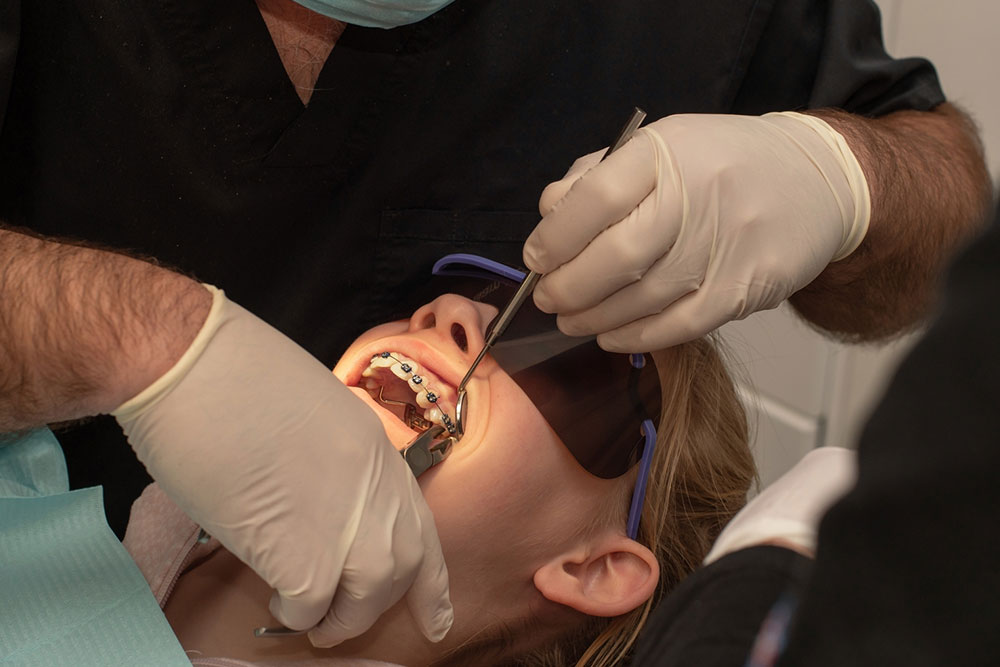
Dental braces – Types, pros and cons, cost, and procedure
Over the years, orthodontics has gained widespread popularity to correct misaligned teeth or malocclusions. As per statistical reports, approximately four million people nationwide wear braces, with teenagers and children constituting the majority of them. Dentists typically recommend wearing braces from an early age to prevent crowding of teeth in the future and set up one’s facial symmetry early on. This article aims to provide insights into braces, their types, procedures, benefits, costs, and more.
Types
Metal braces
These are the traditional braces made of stainless steel bands, wires, and brackets, wherein a bracket is bonded or glued to every tooth, and a flexible archwire is placed over the brackets. Tiny elastic bands called ligatures are also used to hold the wire firmly in its place.
- Pros and cons: Metal braces are affordable and durable and can correct dental issues like gaps between teeth and bite problems. However, they may not be preferred due to their lack of aesthetic appeal and risk of tooth decalcification if improperly maintained.
- Average cost: Standard metal braces cost anywhere from $3,000 to $7,500.
Lingual braces
These braces are similar to the traditional ones but are placed on the back surfaces of the teeth rather than at the front.
- Pros and cons: These braces are sturdy and visually appealing but cost twice as much as metal braces. They may cause a lisp and make cleaning teeth more difficult. They can also cause pain in the cheeks and tongue.
- Average cost: Lingual braces are priced at around $10,000 to $13,000.
Ceramic braces
Ceramic or clear braces employ the same mechanism as metal braces; however, the brackets, wires, and ligatures are the color of one’s teeth, making them less apparent than the traditional ones.
- Pros and cons: Since ceramic braces are less noticeable, they augur well for individuals looking to maintain esthetic appeal. However, these braces are more delicate than metal braces, which increases their risk of breaking. Hence, they are much less durable than traditional braces.
- Average cost: The average cost of ceramic braces is $4,000 to $7,000.
Self-ligating braces
These braces are similar to the traditional ones but incorporate a built-in system to hold the archwire firmly. Hence, they do not entail ligatures.
- Pros and cons: Self-ligating braces are simpler and more discreet than regular braces, with easy cleaning and fewer components. They are colorless and transparent options for those who don’t want visible braces. However, they may be slightly more expensive than traditional metal braces and can irritate the cheeks, lips, and gums.
- Average cost: These braces are priced from $3,500 to $8,500.
Clear aligners
Clear aligners, or “invisible braces,” are dental braces made of transparent plastic. These braces come in a series of trays that should be worn for about two weeks before moving on to the next set. To get the best results, it is suggested that you wear clear aligners for a minimum of 22 hours a day, removing them only during meals or while brushing your teeth.
- Pros and cons: Clear aligners are highly preferred to maintain esthetic appeal while correcting teeth alignment. They are removable, easy to clean, and help prevent dental problems due to the accumulation of food particles. However, they are expensive. Moreover, they may be unsuitable for treating other alignment problems, such as overbites and underbites, which traditional braces can correct quickly.
- Average cost: Clear aligners cost anywhere between $3,000 and $9,000.
Procedure to fix braces
The procedure to fix braces may differ marginally or significantly based on the type of braces chosen. However, the typical procedure to fix braces is as follows:
Consultation with an orthodontist
The first step to fixing braces is to consult an orthodontist to detect the exact issues with one’s dental positioning. The dentist examines one’s teeth manually and through X-ray scans and understands the patient’s dental history.
Deciding the type of braces
If the orthodontist detects the need for braces, the patient and the dentist discuss the available options and the one most suitable in the particular situation. These factors include the patient’s budget range and preference and the prevalence of specific alignment issues like crossbites, overbites, and underbites.
Priming and conditioning of the teeth
The teeth must be polished, conditioned, air-dried, and primed before the brackets are placed on them. This procedure helps ensure that the bonds can form optimally.
Use of dental cement and cheek retractor
A cheek retractor maintains the teeth’s visibility and dryness throughout the procedure. Dental cement is essential to hold the brackets firmly onto the teeth.
Placement of dental braces
The dental braces are then placed on the teeth, and excess dental cement is removed. The bonding of brackets is strengthened with the help of high-intensity light.
Removal of the cheek retractor
Once the dental braces are placed, the cheek retractor is removed, and the dental archwires are set in place.




